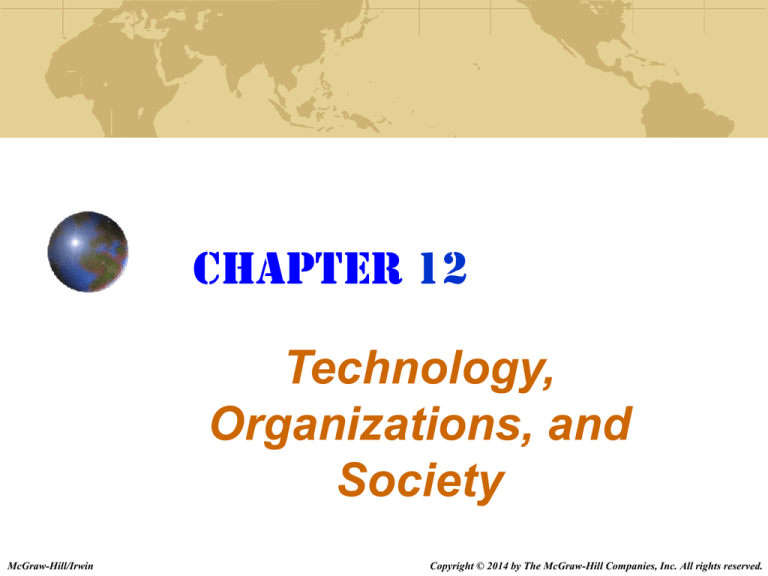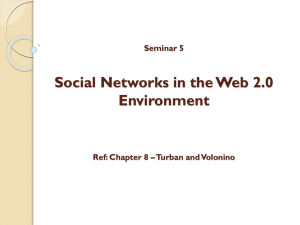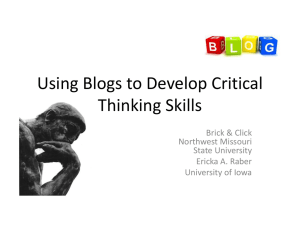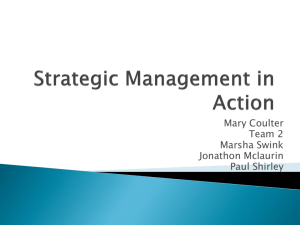
Chapter 12
Technology,
Organizations, and
Society
McGraw-Hill/Irwin
Copyright © 2014 by The McGraw-Hill Companies, Inc. All rights reserved.
Ch. 12: Key Learning Objectives
Defining technology and its characteristics
Recognizing the evolving phases of technology throughout
history and what fuels technological innovation today
Examining how technological innovations have changed
the way organizations operate and interact with their
stakeholders around the world
Analyzing the emerging social networking phenomenon—
texting, instant messaging, tweets, blogs, vlogs, spam,
and phishing—and the challenges they create for
businesses and government policymakers
Recognizing socially beneficial uses of technology in
education and medicine
Evaluating recent efforts to address and narrow the digital
divide
12-2
Technology Defined
Technology – A broad term referring to the practical
applications of science and knowledge to commercial
and organizational activities
Change is the dominant feature of technology
• Sometimes the pace of change is so fast and furious that it
approaches the limits of human tolerance and people lose their
ability to cope with it successfully
Technology’s effects are widespread
• Ripples through society until every community is affected
Technology is self-reinforcing
• Acts as a multiplier to encourage its own faster development
12-3
Figure 12.1 Phases in the
Development of Technology
12-4
Fueling Technological Growth
Government:
Government investment has helped launch many new
technologies, including the Internet, and these trends continue
In 2012, President Obama unveiled his Big Data R&D Initiative
and committed more than $200 million in new funding to
“improve our ability to extract knowledge and insights from large
and complex collections of digital data”
Private investment:
Venture capitalists are investors who provide capital to start-up
companies that do not have access to public funding
They have long targeted technological innovation, with the aim
of making outsized returns
12-5
Fueling Technological Growth
Business investment:
Business firms have invested directly in technology through
their research and development (R & D) operations
These investments have often benefited the business, as well
as produced innovations that have moved their industries
forward
The combination of government, private investor, and
business investment in technology has continued to
drive innovation forward. But, ultimately, technology
continues to evolve because of people’s insatiable
desire for it
12-6
Technology as a Powerful Force in
Business
The Internet
One of the most visible and widely used technological
innovations over the past decade has been the Internet
Springing to life in 1994, the Internet is a global network of
interconnected computers, enabling users to share information
along multiple channels linking individuals and organizations
In 2008, China surpassed the United States with the most
Internet users by country
While opportunities to use the Internet are growing quickly,
some limitations have appeared, such as in China when the
government attempted to convert all identification records to
their digital database systems
12-7
Top
20
Internet
Users
by
Figure 12.2
Country (2008)
12-8
Technology as a Powerful Force in
Business
E-business
Consists of buying and selling goods and services between
businesses, organizations, and individuals electronically via
Internet-based systems
During the past few years, e-business revenue has increased
at a faster pace than that of traditional, or non-electronic,
business
One controversial area where e-business has made a
significant impact is online gambling
12-9
Technology as a Powerful Force in
Business
M-Commerce
Commerce conducted via mobile or cell phones, provides
consumers with an electronic wallet when using their mobile
phones
Given the significant increase in smartphone users,
businesses have looked for ways to reach out to these
potential customers
• QR an abbreviation for “quick response,” consists of a square
made up of black and white spaces that when read by a cell
phone transmits information to the use
12-10
Social Networking – Tools and
Threats
A system using technology to enable people to
connect, explore interests, and share activities around
the world
In 2011, 1.2 billion people worldwide used social
networking sites at least once per month
Examples of the more popular social networking sites
on the Internet include Facebook, MySpace,
YouTube, and Twitter
Each of these popular social networking Internet sites have
their ethical challenges
12-11
Blogs and Vlogs
Blogs – web based journals or logs maintained by an
individual with regular entries of commentary,
descriptions, or accounts of events
156 million blogs counted by BlogPlus
Ethical questions about blogs emerged – For example,
according to a Los Angeles Times report, thousands of
bloggers were being paid by marketing firms to promote or
attack various products on the market
New generation of blogs, called vlogs, or video Web
logs appeared in mid-2000’s
All that was needed was access to a digital camera that could
capture moving images and high-speed Internet access
12-12
Threats from Technology – Spam and
Unsolicited Commercial E-mail
Spam refers to unsolicited commercial e-mails (UCE
or junk e-mails) sent in bulk to valid e-mail accounts
Has become big business and big headache for business
Organizations and individuals have adopted use of spam
blockers, but sometimes difficult to sort out bad emails
Government has attempted to monitor, control and prosecute
spammers using Internet for illegal activity
U.K. and the U.S. have anti-spam legislation
12-13
Threats from Technology – Phishing
Practice of duping computer users into revealing their
passwords or other private data under false pretenses
The Anti-Phishing Working Group, a U.S. industry association,
reported in 2012 that 39 percent of the world’s personal
computers were infected with some type of malware
In 2012, fifteen companies, including e-mail service providers
(Google, Microsoft, and AOL) and financial service companies
(Bank of America, Fidelity Investments, and PayPal), created
DMARC.org (Domain-based Message Authentication,
Reporting and Conformance) to promote a standard set of
technologies intended to lead to more secure e-mail
12-14
Threats from Technology – Government
Censorship of the Internet
Many people believe that information on the Internet
should be universally accessible. Some people
believe that restrictions should be placed on some
categories of information
Some countries have imposed censorship on broad categories
of online information
• The Chinese government operates one of the most sophisticated
systems of Internet censorship in the world
• It requires all China-based Web sites and blogs to register with
the government and blocks access to many kinds of information,
including material critical of the government
12-15
Socially Beneficial Uses of Technology
Technology and Education
Enables students in poor and remote communities to access
the world’s best libraries, instructors, and courses available
through the Internet
Medical Information via the Internet
The abundance of medical information available on the
Internet was welcomed by medical practitioners and the
public in general
• Some warned that this easily available information might create
a group of cyberchondriacs, a term referring to people who leap
to the most dreadful conclusions while researching health
matters online
Another emerging issue focused on digital medical records,
or how a patient’s medical records should be stored and
linked to other health care providers
12-16
Special Issue: The Digital Divide
Gap between those that have technology and those that
do not
Recently, some evidence has suggested that the digital
divide in the United States is becoming smaller
Progress in narrowing the digital divide in developing
countries has been slower, but still evident
Researchers found that the world was becoming more “hyperconnected,” fostering greater global trade and interpersonal
communications online
12-17





